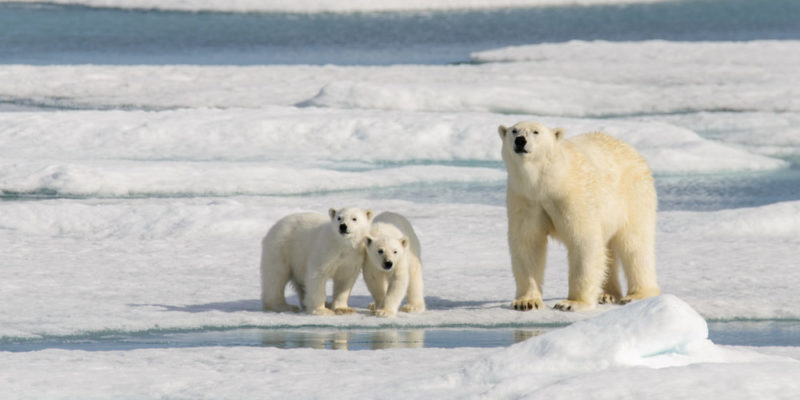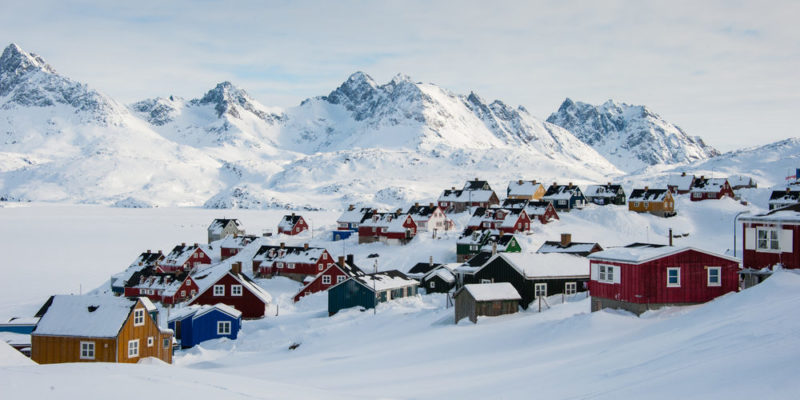We explain what the polar climate is, what its main characteristics and types are. Also, how is the flora, fauna and more.
What is the polar climate?
The polar climate is a type of climate that usually presents temperatures below 0ºC . The average annual temperature does not exceed 10ºC and extends in the areas of the latitudes near the north and south poles , and of the high mountain peaks, such as the Himalayas and the Andes . The regions with polar climates cover 20% of the earth's surface.
For humans, the conditions in these regions are inhospitable, although, from time to time, military expeditions and research projects are carried out in some areas , such as the Russian base Vostok in Antarctica. Some regions of the North Pole are more inhabited by humans.
Characteristics of the polar climate
 The polar climate is characterized by:
The polar climate is characterized by:
- Being the coldest climate on the planet, with temperatures ranging between 8º C and 9º C. The maximum cold recorded was -89º C in Antarctica.
- Spread in the regions of the poles, north and south, and in the highest mountain peaks.
- Have two different seasons of the year, one more extensive and extremely cold, and another warmer and shorter that does not exceed 10º C.
- Present little or no annual rainfall, around 300 mm that falls in solid form or snow.
- Present little or no atmospheric humidity.
- Present strong winds called snowfall or blizzards that, on several occasions, appear together with wind and snow storms.
- Have little fauna and flora.
You may be interested: Arctic Ocean
Types of polar climate
The polar climate is classified into four types:
- Cold continental. It is the climate that extends in the north and northwest of Europe , Canada, Alaska, south and central Siberia.
- Tundra. It is the climate that extends in the areas closest to the poles, such as Western Siberia, Norway and Russia. Average temperatures range between 0º C and 10º C.
- Polar. It is the coldest climate that extends into the areas deep in the north and south poles, with extreme temperatures that can reach -89º C.
- Polar mountainous. It is found in mountain areas near the poles with peaks that exceed 2,000 meters in height and other peaks in mountain systems around the planet that exceed 3,500 meters in height.
Duration of day and night
In the polar regions a unique phenomena occurring on the planet as a result of the tilt of the Earth 's axis and its position relative to the sun . One is the midnight sun or polar day , it consists in that the Sun remains visible on the horizon 24 hours a day around the summer solstice, and the other is the polar night that lasts for more than 24 hours.
Both phenomena occur in polar zones, but they do not occur cyclically at the same points. There are regions where you can see the polar day, but not the polar night . In fact, there are several types of polar night that, in addition, differ according to each region.
Flora of the polar climate
The flora of the polar climate is very particular, it is characterized by being scarce and small in size , due to the fact that the soil is frozen most of the time, the temperatures are very cold and there is no rainfall.
However, in the warmer season some mosses , lichens and small shrubs usually grow .
Fauna of the polar climate

The fauna of the polar climate is more abundant in the northern hemisphere than in the southern hemisphere , due to the more favorable environmental conditions. Animals have particular physical characteristics that allow them to withstand harsh conditions, for example, dense coats, abundant subcutaneous fat, and strong legs.
The main animals of the polar climate include the polar bear, the arctic fox, the arctic wolf, the arctic hare and the reindeer . Some of them tend to emigrate in times of extreme cold.
The birds tend to migrate in the extreme winter season to warmer coasts. Aquatic animals represent the greatest diversity of Arctic wildlife species, such as penguins, Atlantic puffin, seals, Arctic wolf, whales, and fish .
Antarctica, at the south pole, is the coldest, driest and windiest region on the planet, so there is almost no terrestrial fauna. Yes, the marine fauna is abundant, with animals such as krill, whale, squid, cod, and fica, among others.
Human population

The human population in regions with a polar climate is very scarce due to the inhospitable conditions of the environment , such as the scarcity of vegetation, the reduced fauna and the extreme cold temperatures that are difficult for the organism to bear.
However, there are populations of Eskimos or indigenous people that inhabit arctic regions of North America and Siberia, such as the Inuit, the Yupik and the Sadlermiut. They are nomads who evade the extreme cold season and hunt caribou, bears, whales and seals.
Eskimos obtain virtually everything they need for food , clothing, and shelter from the animals they hunt. To build their homes they use certain types of snow and wood for furniture.
The above content published at Collaborative Research Group is for informational and educational purposes only and has been developed by referring reliable sources and recommendations from technology experts. We do not have any contact with official entities nor do we intend to replace the information that they emit.
She has pursued her studies in The United States, where she has graduated in Business and Economics and is currently finishing her Master studies in International Economics and Finance. Miss. Amputee is fluent in three languages: English, Spanish and Russian and has elementary knowledge of French and Italian. She love exploring how Collaborative Research Group can become the best tool to achieve the (necessary) educational change. .
Leave a reply
Your email address will not be published. Required fields are marked *Recent post

Sport: What Is It, Types, Risks, Features, Characteristics and Examples

Dogs: Emergence, Features, Characteristics, Feeding and Breeds

Story: Definition, Elements, Structure, Features and Characteristics

